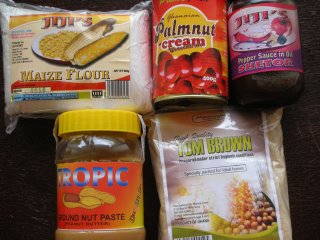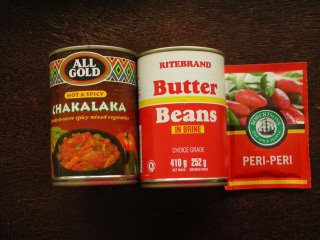West African Convenience Foods and Inter-African Culinary Influences

Ghanaian Convenience foods
Since arriving in Ghana I’ve been dealing with some food challenges. The first one is getting/making fermented corn/cassava dough for banku and koko (porridge). With our minimalist kitchen in Legon and no car or household help, I’m ill-equipped to get involved in the time- and equipment-consuming tasks of preparation (e.g., soaking, then grinding the corn or cassava). It’s not a simple task of running to a market to have things ground or pick up what I need. Plus, the big supermarkets (Koala in Osu, Shoprite in Accra Mall) do not sell these types of Ghanaian foods, either. There are “instant” powdered versions on the market, but so far my husband and I have tossed out all of them we’ve tried. However, we have found shito (a special Ghanaian hot pepper sauce) and groundnut paste (peanut butter) made locally that we like.
In the U.S I use fufu powder to prepare and eat “make-do” fufu, and I make banku and kenkey from stoneground cornmeal and cornstarch, even though the dough lacks the proper flavor and texture. Here in Ghana I haven’t yet found any trusted small producers who can reliably supply me. Of course, I can eat many of these dishes in restaurants, but it would be nice to be able to prepare them at home. I’ll keep looking.
This conversation reminds me of an interesting article by Elisha P. Renne in a recent issue of American Anthropologist: “Mass Producing Food Traditions for West Africans Abroad” (Dec. 2007, Vol. 109, Issue 4, pp 616-625). It talks about how West Africans who are abroad and thus away from home turn to processed, prepared foods that use production processes that are “ideologically similar . . .but technologically very different” from traditional techniques. She illustrates with examples of palmnut concentrate, fufu powder, attiéké, and Nigerian chin-chin, It strikes me as an accurate and timely look at the diffusion of West African ingredients and culture into North American markets, with explorations of how memory, taste, and social identities interact. There are a few minor errors in the article, but it’s well worth reading.
Renne's article reminded me of an interesting paper presented by Tulasi Srinivas at the Joint 2006 Annual Meetings of the Association for the Study of Food and Society (ASFS) and the Agriculture, Food, and Human Values Society (AFHVS) at Boston called “'As Mother Made It': Global Food, the Indian Family and the Construction of Cultural Utopias," which explored how a whole industry has emerged in India to reproduce the labor-intensive meals craved by well-to-do but time-strapped Indian professionals in places like the U.S. I wonder if the same thing will happen for West Africans? I think of the individual-sized portions of Indian food being sold, and think of West African portion sizes, and I wonder. . .
Shoprite and Inter-African culinary influences

There was an article a few years ago about how supermarket chains from South Africa are beginning to spread into other African nations (Weatherspoon and Reardon, “The Rise of Supermarkets in Africa: Implications for Agrifood Systems and the Rural Poor,” Development Policy Review, 2003, 21 (3): 333-355.) Recently South African-based Shoprite, the biggest retailer in Africa, has opened a store in Accra. It reminded me how increasingly countries on the continent are being influenced by the foods of other African nations. For example, for the first time in Ghana I see canned South African chakalaka salad and butter beans on the shelves, along with numerous curry and periperi seasonings. Similarly, restaurants on campus here at Legon cater to Nigerian students and visitors (like the hundreds of Nigerians who came to see the African Cup of Nations matches) by preparing some of their specialties, such as eba (from gari), iyan (pounded yam) and Nigerian-style egusi (melon-seed) stew. Also, the newly opened branch of Maquis Tante Marie at the Accra Mall provides, as does its North Labone branch, upscale West African cuisine from a variety of both Francophone and Anglophone nations.
Labels: african convenience foods, maquis tante marie, Renne, shoprite, Srivinis

